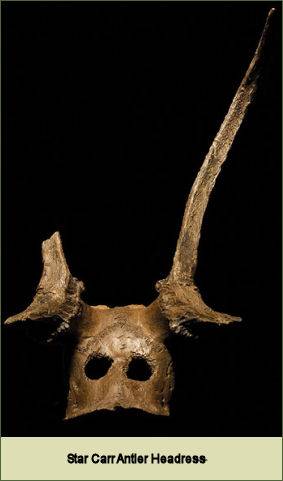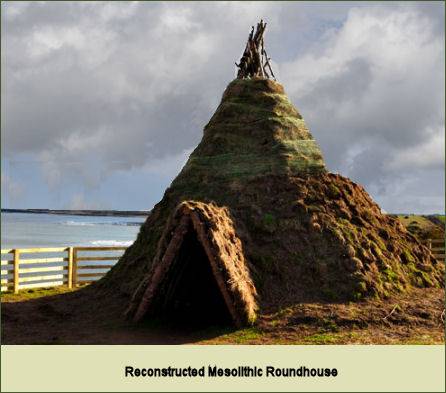Star Carr
OS grid reference:- TA 027 810
 Star Carr Mesolithic archaeological site is located beneath farmland at the eastern end of the Vale of Pickering. It lies around five miles (8.0 km) to the south of the coastal town of Scarborough in an area known as the Carrs, below the southern fringe of the North York Moors. The site is believed to be comparable in archaeological importance to Stonehenge.
Star Carr Mesolithic archaeological site is located beneath farmland at the eastern end of the Vale of Pickering. It lies around five miles (8.0 km) to the south of the coastal town of Scarborough in an area known as the Carrs, below the southern fringe of the North York Moors. The site is believed to be comparable in archaeological importance to Stonehenge.
It is generally regarded as the most important Mesolithic (Middle Stone Age) site in Britain and arguably one of the finest Mesolithic sites in northern Europe.
Star Carr dates from around 8,700 BC and was occupied during the early Mesolithic period, when Britain had not yet become an island. Although the ice sheets had receeded and temperatures were then near to modern ones, sea levels had not yet risen enough to divide Britain from continental Europe.
 As the ice retreated groups of hunter gatherers followed the herds of migrating animals across land which now lies beneath the North Sea. Some of these settled on the shores of the prehistoric Lake Flixton, where they removed the rushes at the marshy edges of the lake and lay mats of brushwood and a wooden trackway of hewn and split timbers to form a platform out into the deeper water. This trackway has been claimed as the oldest example of carpentry so far discovered in Europe. The unearthed remains of a wooden paddle provides evidence that the inhabitants of Star Carr also used boats to catch fish in the lake. The people of Star Carr hunted such animals as deer, wild boar, elk and huge wild cattle known as auroch, an extinct wild ox which once roamed Europe.
As the ice retreated groups of hunter gatherers followed the herds of migrating animals across land which now lies beneath the North Sea. Some of these settled on the shores of the prehistoric Lake Flixton, where they removed the rushes at the marshy edges of the lake and lay mats of brushwood and a wooden trackway of hewn and split timbers to form a platform out into the deeper water. This trackway has been claimed as the oldest example of carpentry so far discovered in Europe. The unearthed remains of a wooden paddle provides evidence that the inhabitants of Star Carr also used boats to catch fish in the lake. The people of Star Carr hunted such animals as deer, wild boar, elk and huge wild cattle known as auroch, an extinct wild ox which once roamed Europe.
Excavation of the site began in 1948, following artefacts being first uncovered there by John Moore, an amateur archaeologist. The site was first excavated between 1949-1951 by Sir Grahame Clark. It had been preserved due to Lake Flixton in-filling with peat during the course of the Middle Stone Age. The lake is now a carr, an area of waterlogged soil with reeds and alders. Waterlogged peat prevents organic finds from rotting and has led to some of the best possible preservation conditions, similar conditions have preserved the famous bog bodies such as Lindow Man found at Lindow Moss in Cheshire and at in other places in northern Europe.
 Some of most impressive finds from Star Carr include barbed points and' antler headdresses. The barbed points, of which nearly 200 were found, are made of red deer antlers. They measure between 8 centimetres (3.1 in) and 38 centimetres (15 in) long, some 195 examples were found at Star Carr.
Some of most impressive finds from Star Carr include barbed points and' antler headdresses. The barbed points, of which nearly 200 were found, are made of red deer antlers. They measure between 8 centimetres (3.1 in) and 38 centimetres (15 in) long, some 195 examples were found at Star Carr.
The antler headdresses are made of red deer stag skulls with the antlers still in position, these were sewn into leather and have been interpreted as some form of ceremonial headdress worn by a hunter or hunter-shaman during hunting rituals. Beads of shale and amber were also uncovered. Carbon dating of the artifacts provides a date range of activity at Star Carr of between 8770BC-8460BC. Finds from the site can be viewed at the Rotunda Museum in Scarborough.
The archeological finds at the site include Britain's oldest structure, a circular house, which has been dated as being constructed in 8,500BC. Described as a "sensational discovery" by archaeologists, it is 500 years older than the previous oldest house, in Howick, Northumberland. The round house, which was a smaller version of iron age round houses, was built with a circle of timber posts around a sunken circular floor area, which may have been covered by reeds.
It is not known how the walls and roof were covered, but it may have been thatched or used animal hides. The discovery of the house attracted worldwide media attention and challenged pre-conceived ideas about ancient hunter gatherer communities.
Directions
The Star Carr site is situated South of Seamer to the east of the A64, access is via a farm track.
Prehistoric and Roman Sites of Yorkshire
